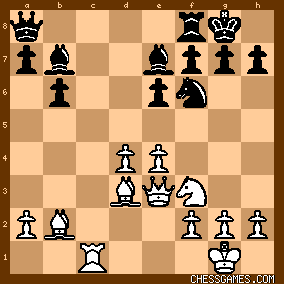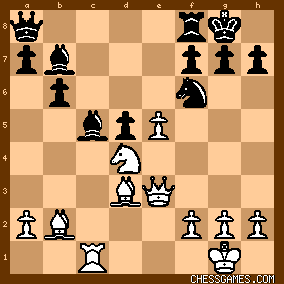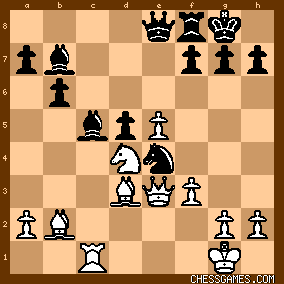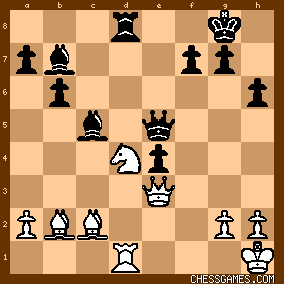| offramp: Let us now take up the question as to how position with a fixed centre can be changed into central formations of another type. By demolishing the opponent's pawns one can easily change the position from that of a fixed to a mobile central type, and if both players' pawns disappear then an open centre may arise. Alternatively, from positions with a closed center, there can easily arise the type with fixed centres and even mobile centres may occur. A problem which demands particular care arises when the player who has the mobile centre must determine in what fashion it should be fixed. It is then that a player may get into great difficulties which demand the greatest playing skill. Let us, for example, consider the following example. In this there occurs an interesting case of change in the centre.

click for larger view
In this there occurs an interesting case of change in the center! In this position, Black exerts strong pressure on e4. If White confines himself merely to defending the pawn then he runs the risk of having the initiative taken out of his hands. So he must do something about his pawn position in the centre. But what? Why not play P-K5?
(Such a move is indeed playable at the appropriate time. In this connexion the reader should study the game Kotov vs Gligoric, 1947, but it should be observed that special positional circumstances existed to justify the move.) Lillienthal finds an elegant solution to the difficult problem.
17. d5! exd5
18. Nd4!
A remarkable move. Now he threatens the decisive 3. Nf5 and 4. Qg5. Quite suddenly Black's position takes on a most unprepossessing appearance. White has opened up the centre and has not only activated his Bishops but has also united all his pieces for the attack in the ensuing moves.
18...Bc5
19. e5.

click for larger view
Lilienthal wants to use his pawns for the attack, but in so doing he allows his opponent the opportunity of organizing a defence. Excellent winning chances would have been given by <19.Rxc5 bxc5 20.Nf5 d4 21.Qg5.>
19...Ne4
20. f3 Qe8!
Excellent! By means of the piece sacrifice Black obtains a dangerous mobile centre supported by active forces.

click for larger view
21.fxe4 Qxe5
22. Re1 Re8.
Now Black gains his third pawn for the Knight and thus, in addition to everything else, he restores the balance in material. White must in his turn strive for equality.
23. Kh1 dxe4
24. Bc2 Rd8
25. Rd1 h6

click for larger view | 




































